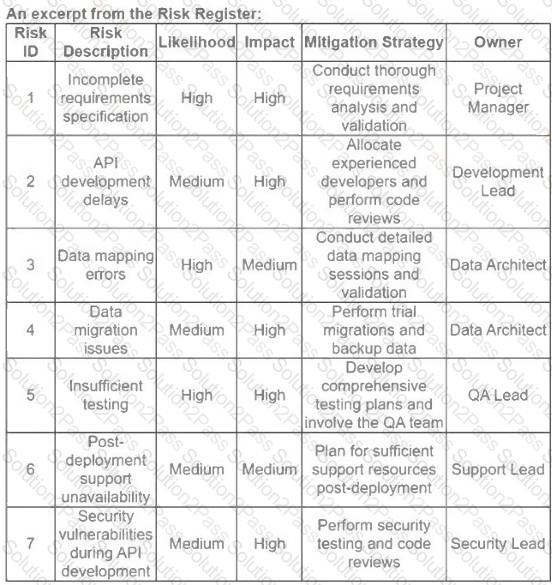PMI-200 PMI Agile Certified Practitioner (PMI-ACP) Free Practice Exam Questions (2025 Updated)
Prepare effectively for your PMI PMI-200 PMI Agile Certified Practitioner (PMI-ACP) certification with our extensive collection of free, high-quality practice questions. Each question is designed to mirror the actual exam format and objectives, complete with comprehensive answers and detailed explanations. Our materials are regularly updated for 2025, ensuring you have the most current resources to build confidence and succeed on your first attempt.
A key resource is switching between projects to obtain more visibility and acclaim. However, project work has grown and become a burden.
What should the agile project leader do?
A product owner concludes that the majority of a project's value can be delivered by completing only the first half of the prioritized backlog. What should the product owner do next?
An agile practitioner is in the process of refining requirements. The requirements keep changing based upon with whom the agile practitioner speaks.
What should the agile practitioner do in this situation?
An agile lead is experienced with predictive and agile approaches. The agile lead was recently invited by human resources (HR) to be part of a learning team. During roundtable discussions with the project management team, the agile lead states: "I foster a safe environment for disagreement so my team feels empowered to move forward without obstacles."
What is the agile lead attempting to highlight?
The agile practitioner has determined that two different team members are working on addressing the same major issue on the project. How should the agile practitioner address this?
An agile team is working on the first sprint, and have already planned the second and third sprints. However, market conditions now require a change to the features. What should the product owner do?
An agile project leader notices that the team's velocity has decreased in examining data provided by team members, the project leader discovers that one team member has been slow to enter story statuses
What can happen as a result?
How can an agile team working on a new product ensure alignment with external stakeholders?
An agile project was underway for two months and delivered the expected value to the stakeholders. However, during a sprint review, a team member complained that the product owner constantly changes requirements and the member feels that this is blocking the team’s performance.
How can the scrum master handle this situation?
An agile team and a traditional development team are working together on a project. Each team exceeds expectations regarding deliverables: however, issues arise when the deliverables are integrated. What should the agile practitioner do?
During planning sessions an agile practitioner notices that some team members do not share common ideas What should the agile practitioner do?
An agile team's client has been asked to expedite the delivery of the next release. By delivering one month early, the company can generate USS40.000 more than expected for the quarter. What should the agile team do?
A project team has a senior subject matter expert (SME) who is comfortable with data integration. The SME is not inclined to perform regression testing because the SME feels that performing regression testing is more of a junior duty.
What should the scrum master do?

An e-commerce company acquired a tool to customize subject line generation for marketing campaigns. In sprint planning, the team discussed integrating this tool with the customer relationship management system.
Which mitigation strategy is most appropriate to ensure the final product meets the business objectives? (Refer to the Risk Register Exhibit)
A project manager is leading a large agile project with multiple deliverables at each phase of completion. The project team has informed the project manager that the deliverables are completed per the team agreement.
Which agile practice should the project manager advise their team use to ensure deliverables are completed and ready for release?
During an executive review, a scrum master uses a burndown chart to demonstrate team deliverables through time. The scrum master declared that velocity increased from 27 to 35 over the last 3 sprints, but one of the executives asks to clarify the importance of these metrics.
How should the scrum master respond?
A product owner wants to create a release plan given the team is working in a chaotic environment. They want to set expectations about what is likely to be developed and in what timeframe for some of the stakeholders.
What should the product owner include in the release plan to achieve this?
A client is pressed for time and wants to launch a product with three components as soon as possible to gain market share. An agile lead proposes the following agile strategy to gain time: Three teams will work on the design and development of each component. Once all three components are finished, they will be tested and integrated.
Is this agile strategy appropriate?
During an interview for an agile team lead for a global company, a candidate is asked: "How do you ensure your project is aligned with the stakeholders' priorities?"
How should the candidate respond?
Team A is working on the second sprint of a product release Team B which is an interdependent team located on the same floor, requires extensive and frequent information to complete its sprint goal.
What should the agile team lead do?
